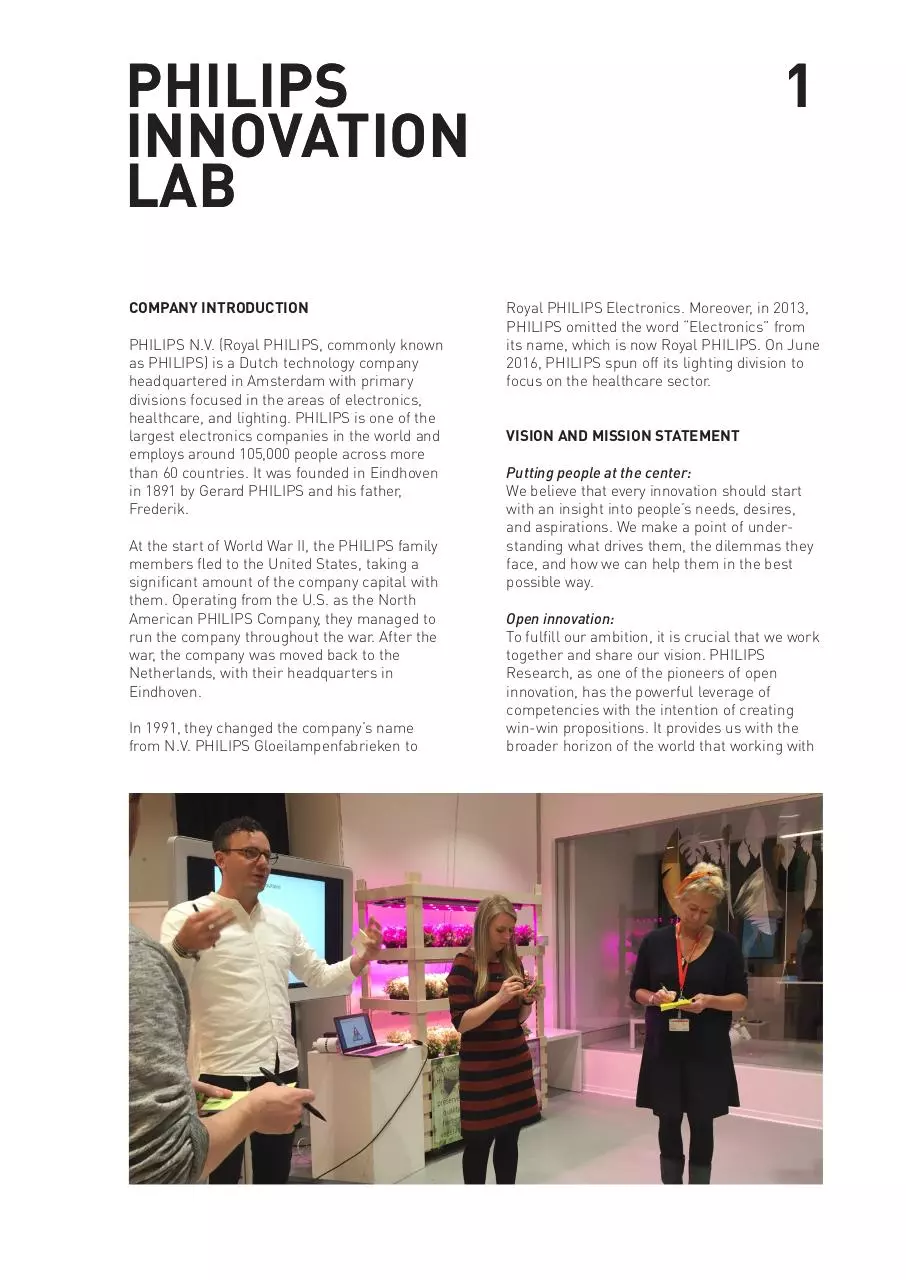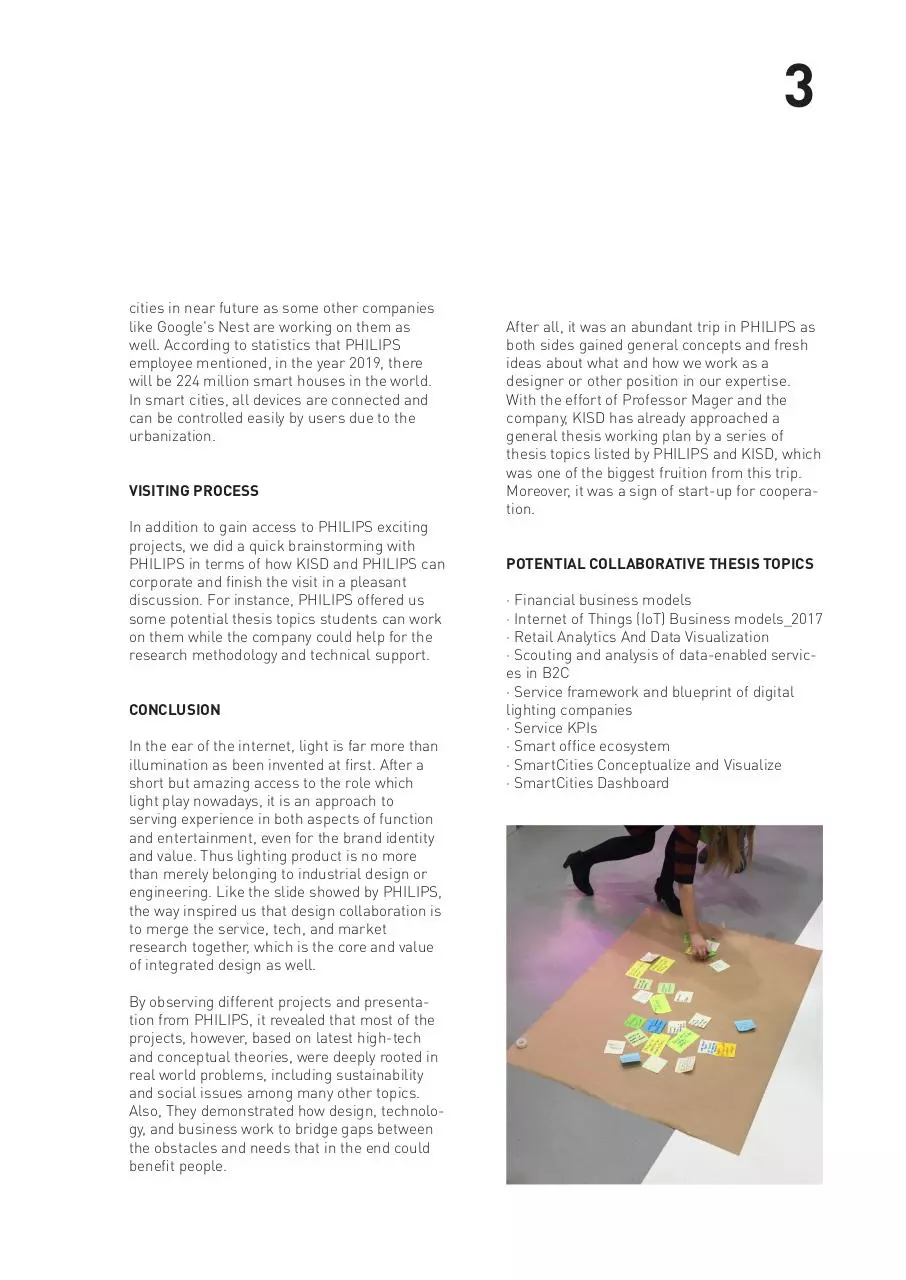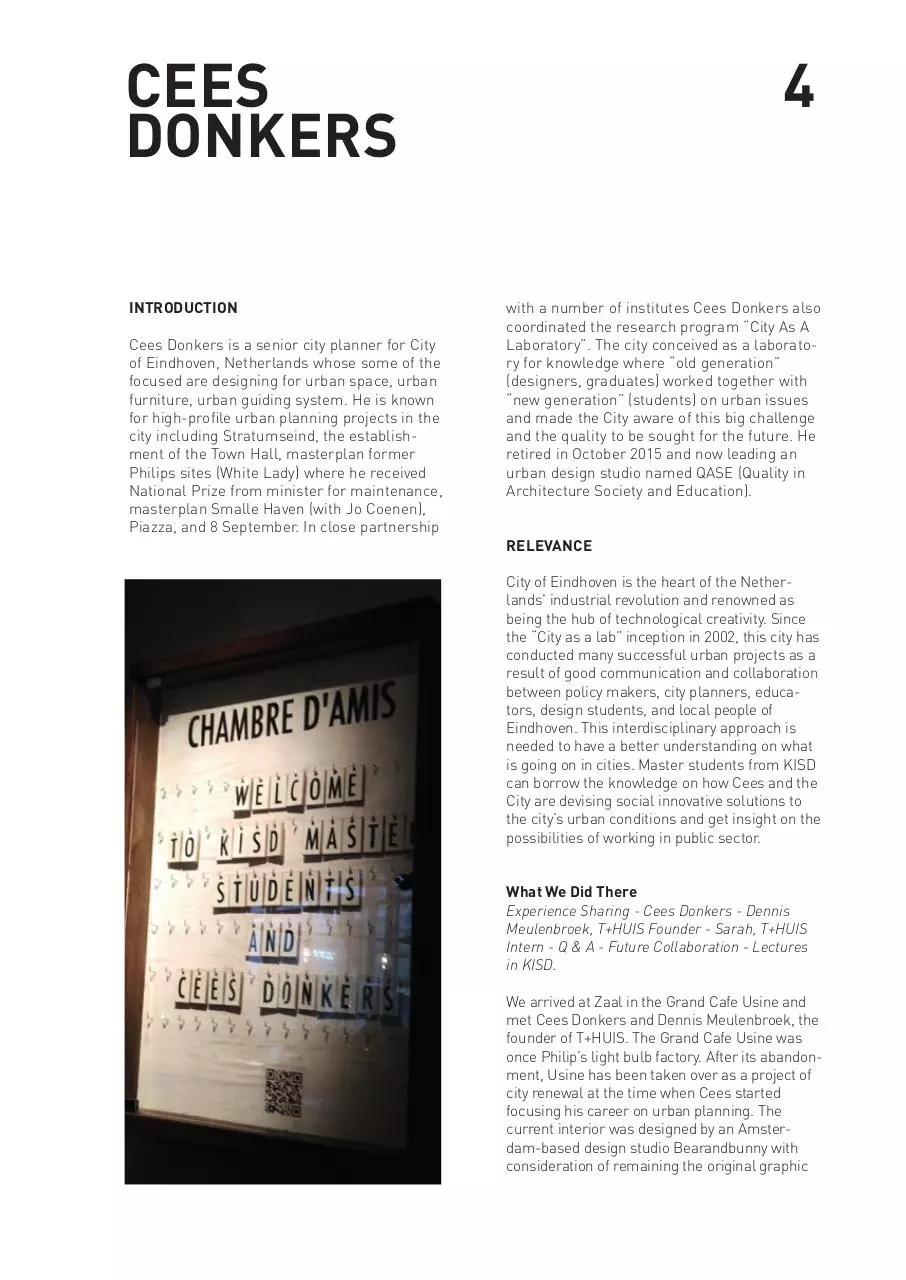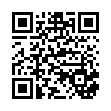PO2 Reports Final PostCorrection (PDF)
File information
Title: PO2_Reports_Final_PostCorrection
This PDF 1.4 document has been generated by Adobe Illustrator CS6 (Macintosh) / Adobe PDF library 10.01, and has been sent on pdf-archive.com on 27/02/2017 at 17:11, from IP address 186.29.x.x.
The current document download page has been viewed 372 times.
File size: 7.11 MB (20 pages).
Privacy: public file





File preview
PHILIPS
INNOVATION
LAB
COMPANY INTRODUCTION
PHILIPS N.V. (Royal PHILIPS, commonly known
as PHILIPS) is a Dutch technology company
headquartered in Amsterdam with primary
divisions focused in the areas of electronics,
healthcare, and lighting. PHILIPS is one of the
largest electronics companies in the world and
employs around 105,000 people across more
than 60 countries. It was founded in Eindhoven
in 1891 by Gerard PHILIPS and his father,
Frederik.
At the start of World War II, the PHILIPS family
members fled to the United States, taking a
significant amount of the company capital with
them. Operating from the U.S. as the North
American PHILIPS Company, they managed to
run the company throughout the war. After the
war, the company was moved back to the
Netherlands, with their headquarters in
Eindhoven.
In 1991, they changed the company’s name
from N.V. PHILIPS Gloeilampenfabrieken to
1
Royal PHILIPS Electronics. Moreover, in 2013,
PHILIPS omitted the word “Electronics” from
its name, which is now Royal PHILIPS. On June
2016, PHILIPS spun off its lighting division to
focus on the healthcare sector.
VISION AND MISSION STATEMENT
Putting people at the center:
We believe that every innovation should start
with an insight into people’s needs, desires,
and aspirations. We make a point of understanding what drives them, the dilemmas they
face, and how we can help them in the best
possible way.
Open innovation:
To fulfill our ambition, it is crucial that we work
together and share our vision. PHILIPS
Research, as one of the pioneers of open
innovation, has the powerful leverage of
competencies with the intention of creating
win-win propositions. It provides us with the
broader horizon of the world that working with
2
potential strategic partners, future suppliers of
our businesses.
Global Desmands, Local Needs:
We apply our expertise to address growing
global demands for greater energy efficiency
and higher levels of sustainability in all aspects
of new products and technologies. At the same
time, we have a growing presence in emerging
markets, which enables us to deliver innovations that address local market needs.
Surprising Innovations:
For over a century, our approaches have
allowed us to surprise people with breakthrough innovations. Along the way, we have
been responsible for some truly ground-breaking discoveries and standards, such as the
Rotax X-ray tube, the high-pressure mercury
lamp, the triple-headed dry electric razor, the
Compact Cassette, and more recent innovations like the Brilliance 40 slice CT scanner,
CD, DVD, and Ambilight TV.
VISITING PROCESS
We started the tour including some projects
PHILIPS has done after a brief introduction.
The first section was an off-line fashion
clothing shop focusing on user experience as
the core value of the brand. What impressed us
was how lights influenced our visualization of
the products. The employee showed one case
as when several same pairs of white T-shirts
and blue jeans were under different white-colored lights, light's temperature and hue can
completely change the reflected color to
customers, which was fantastic! It is crucial to
delivering the accurate perception of product
color by applying good lights.
Future clothes shops will be changed dramatically regarding user/customer experience by
implementing new technologies which PHILIPS
took into consideration such as the multi
lighting choices in the fitting room to point out
the clothes’ color may “change” in different
potential dressing situations. Besides, mirrors
as parts of a clothes shop, the PHILIPS makes
mirror far more than just reflecting by VR tech.
With a VR- Headset, the customer can see
oneself in new clothes while without taking off
them, which lead to energy and time saving.
Another section is city farming. As PHILIPS
employees explain, shortly city farming will
grow remarkably. PHILIPS is right now working
on new light systems related to indoor farming
to make plants grow with high efficiency. This
project can be considered as one of the
elements of smart houses as part of smart
3
cities in near future as some other companies
like Google's Nest are working on them as
well. According to statistics that PHILIPS
employee mentioned, in the year 2019, there
will be 224 million smart houses in the world.
In smart cities, all devices are connected and
can be controlled easily by users due to the
urbanization.
VISITING PROCESS
In addition to gain access to PHILIPS exciting
projects, we did a quick brainstorming with
PHILIPS in terms of how KISD and PHILIPS can
corporate and finish the visit in a pleasant
discussion. For instance, PHILIPS offered us
some potential thesis topics students can work
on them while the company could help for the
research methodology and technical support.
CONCLUSION
In the ear of the internet, light is far more than
illumination as been invented at first. After a
short but amazing access to the role which
light play nowadays, it is an approach to
serving experience in both aspects of function
and entertainment, even for the brand identity
and value. Thus lighting product is no more
than merely belonging to industrial design or
engineering. Like the slide showed by PHILIPS,
the way inspired us that design collaboration is
to merge the service, tech, and market
research together, which is the core and value
of integrated design as well.
By observing different projects and presentation from PHILIPS, it revealed that most of the
projects, however, based on latest high-tech
and conceptual theories, were deeply rooted in
real world problems, including sustainability
and social issues among many other topics.
Also, They demonstrated how design, technology, and business work to bridge gaps between
the obstacles and needs that in the end could
benefit people.
After all, it was an abundant trip in PHILIPS as
both sides gained general concepts and fresh
ideas about what and how we work as a
designer or other position in our expertise.
With the effort of Professor Mager and the
company, KISD has already approached a
general thesis working plan by a series of
thesis topics listed by PHILIPS and KISD, which
was one of the biggest fruition from this trip.
Moreover, it was a sign of start-up for cooperation.
POTENTIAL COLLABORATIVE THESIS TOPICS
· Financial business models
· Internet of Things (IoT) Business models_2017
· Retail Analytics And Data Visualization
· Scouting and analysis of data-enabled services in B2C
· Service framework and blueprint of digital
lighting companies
· Service KPIs
· Smart office ecosystem
· SmartCities Conceptualize and Visualize
· SmartCities Dashboard
CEES
DONKERS
INTRODUCTION
Cees Donkers is a senior city planner for City
of Eindhoven, Netherlands whose some of the
focused are designing for urban space, urban
furniture, urban guiding system. He is known
for high-profile urban planning projects in the
city including Stratumseind, the establishment of the Town Hall, masterplan former
Philips sites (White Lady) where he received
National Prize from minister for maintenance,
masterplan Smalle Haven (with Jo Coenen),
Piazza, and 8 September. In close partnership
4
with a number of institutes Cees Donkers also
coordinated the research program “City As A
Laboratory”. The city conceived as a laboratory for knowledge where “old generation”
(designers, graduates) worked together with
“new generation” (students) on urban issues
and made the City aware of this big challenge
and the quality to be sought for the future. He
retired in October 2015 and now leading an
urban design studio named QASE (Quality in
Architecture Society and Education).
RELEVANCE
City of Eindhoven is the heart of the Netherlands' industrial revolution and renowned as
being the hub of technological creativity. Since
the “City as a lab” inception in 2002, this city has
conducted many successful urban projects as a
result of good communication and collaboration
between policy makers, city planners, educators, design students, and local people of
Eindhoven. This interdisciplinary approach is
needed to have a better understanding on what
is going on in cities. Master students from KISD
can borrow the knowledge on how Cees and the
City are devising social innovative solutions to
the city’s urban conditions and get insight on the
possibilities of working in public sector.
What We Did There
Experience Sharing - Cees Donkers - Dennis
Meulenbroek, T+HUIS Founder - Sarah, T+HUIS
Intern - Q & A - Future Collaboration - Lectures
in KISD.
We arrived at Zaal in the Grand Cafe Usine and
met Cees Donkers and Dennis Meulenbroek, the
founder of T+HUIS. The Grand Cafe Usine was
once Philip’s light bulb factory. After its abandonment, Usine has been taken over as a project of
city renewal at the time when Cees started
focusing his career on urban planning. The
current interior was designed by an Amsterdam-based design studio Bearandbunny with
consideration of remaining the original graphic
5
and identity of this monumental building.
Nowadays, the Grand Cafe Usine is one of the
most symbolic social hubs where many brilliant
ideas were discussed and exchanged.
Cees introduced us how his career started during
the transformation period of the city Eindhoven.
Some indicative projects achieved through his
active years with cooperations of public and
private sectors have been shared. The Witte
Dame (White Lady), as an example, was one of
his iconic success in maintaining industrial
heritage. It was a former factory from Philips kept
from demolishment due to the student protests,
including Cees. The keen engagement of
students, the second generation, artists, and
designers altered the climate toward policy
decisions of the city council. These bottom-up
events led to practical discussions and involved
inhabitants to take in charge of the fate of their
city. Nowadays, the Witte Dame has been converted into a multifunctional building for the accommodation of the Design Academy, part of the city
library, and department office of Philips Lighting.
In addition to his great passion on practicing
design, Cees also dedicated to designing education in nurturing the new generation. Dennis
Meulenbroek, for instance, is one of the very first
generations of the Design Academy Eindhoven.
He has been inspired by the city and decided to
stay. With the aim of reconstructing the empty
former industrial zone of Philips, Dennis founded
T+HUIS, a design company served with a social
purpose to help reconnecting the neighborhoods. Together with Cees, they worked on
projects of city-wide scale, building a platform
for open debates and discussions. We also
listened to Sarah, the T+HUIS intern, sharing one
project successfully guiding child refugees to
learn English with innovative approaches.
THE DISCUSSIONS AND QUESTIONS
Some of the most inspiring discussions are:
What is your view on global collaboration? Can
lessons learned be shared across different cities
to address similar problems, or maybe each city
have its own set of problems and therefore needs
its own set of solutions?
According to Cees, we can’t copy conceptual
contexts as urban issues usually deeply rooted in
localities, but we can copy the looking and adjust
it to a different local context. We should start to
learn about and understand countries from
around the world, and actually combine efforts in
facing globalisation.
As an intercultural hub of city as Cologne, how
do you bring the relevance to communities such
as foreigners, students, immigrants who use
6
Cologne as a stepping stone to look for a better
future to be aware of their responsibility of being
a citizen and devote to the city formation?
we love what you are doing, we will never get
bored of it.
The focal point of city planning stresses not on
the permanent residents, but if the inhabitants
can contribute their knowledge. The value of
urban society is the exchange of ideas on an
international level. The power of sharing guides
us to face the fast-developing environment as
an integral community that tightens up the
neighborhood.
IMPRESSION AND CONCLUSION
What are the most important thing for design
students that need to prepare, especially for
those who want to work within the public space?
Design students need to have passion in
building society while keep mastering one or
two design fields or skills that will be used as
a weapon to convey the message. And if you
want to resolve a social problem through
design, it is important to talk directly to social
workers who know the actual situation rather.
The truth is we have to work on our passion. If
It’s been a precious experience to talk with
Cees Donkers and Dennis Meulenbroek who
clearly have big passions in what they are
doing. Through discussions and stories from
Cees’s 40 years of work experience, we learned
how design plays a role in public domains and
influences the next generations. One of the
biggest lessons that we took by heart was to
think about design and its social conscience.
As designers, we have the responsibility to
explore the potential of social design and social
innovation within the urban context. Design can
also be a critical tool in researching and
developing relevant strategies and systems for
people and their neighborhoods. Design
thinking can be applied within the social field in
order to find opportunities for society to
realising their full potential. Overall, it was a
very inspiring evening.
VOLKSWAGEN
INNOVATION
HUB
COMPANY INTRODUCTION
Volkswagen Group (VW) is an automotive
company established in the 1930`s with
Headquarters in Wolfsburg, Germany. The
Volkswagen labs in Germany are in Berlin
(Ideation:Hub), Munich and Wolfsburg and
they come up with new IT solutions for areas
such as Industry 4.0, big data, advanced
analytics, machine learning, and the internet
of things. The labs also function as catalysts
for new work models and personnel
recruitment methods. Volkswagen includes
brands such as Volkswagen, Audi, Porsche,
SEAT, Scania, Bentley, Lamborghini and
Skoda. VW also own the brand Volkswagen
Institute which is focused on employee skills
development and language learning, and
Volkswagen Bank, which is a financial
institution focused on savings and
investments.
THE IDEATION HUB
The Ideation: Hub was set up un October 2015
with the finality to drive its efforts in the
7
future areas of IT, digitalization and
autonomous driving. In the Ideation:Hub they
have been working in topics such as Electric
Mobility, Connectivity and Car Sharing through
Service Design but at the beginning they
called it as a Service innovation and Business
innovation then they moved into Service
design and Felix Scharf described Service
Design “is not just looking in a superficial
level but is also looking in deep”.Felix Scharf
business innovation manager at Volkswagen
said: It´s all about communication, creative
ideas are generated throughout the
Volkswagen Group. The “Ideation:Hub” pools
these ideas and brings together the people
behind them also networking with start-ups
outside the Group.
OUR HOST
Felix Scharf, with an education background in
Sociology Psychology and Media Science, now
performs in Volkswagen as a business
innovation manager. Felix has a broad
experience in Business Intelligence, Service
Design and Business Design with a scope in
8
Multi-Brand and Multi-Market. Some of the
topics he has worked with during his
experience in Volkswagen are New Mobility,
eMobility, electric Mobility, Urban Mobility,
Urban Development, New Energy,
Mobility-on-Demand, In-Car-Connectivity,
eCommerce
THE TALK
We had a one hour open discussion with Felix
about the way innovation is being conducted
at Volkswagen, at the end we had the
opportunity to ask and post interesting
questions. He first gave us a brief explanation
and first thoughts about the process of
innovation and the mindset he follows when
he deals with innovation paradigms. He
presented a really interesting way to look into
the different horizons of a company and made
some statements about the importance of
balancing the operations while finding the
right amount of people who will work
developing the next horizons of a company
(three horizons of growth). As seen in the
picture H1 represents the “now” of a company
which concentrates 80% of the company's
human resources, basically H1 refers to the
operations and core structure of a company, it
is what brings value to it today. In H2 which
should concentrate 15% of the company's
human resources is the horizon of Business
building, which will create new opportunities
and will identify some disruptions and finally
H3 with the 5% of the people who are mostly
visionaries working in creating viable options,
those are the ones who keep open to all
options and could lead to a transformational
and visionary change of the company.
Felix depicted as well a chart about the focal
points a company has to consider when
dealing with a successful business paradigm
where the balance between the way a
company deals with Operations, Technology,
User Experience and Business Innovation is
crucial to maintain a company through time.
CONCLUSION
The talk with Felix was really productive to see
the way innovation is driven in multinational
corporations. The small window opened to
KISD students, was an opportunity to reflect in
the different role designers could take within a
company. We concluded that there are
designers also working in each Horizon, while
designers in the H1 are more skilled driven,
designers in H2 and H3 are concerned with
more business and design management
skills. This drew a map that triggered self
reflection on the roles each one of us would
personally like to take as designers in the
professional atmosphere.
Download PO2 Reports Final PostCorrection
PO2_Reports_Final_PostCorrection.pdf (PDF, 7.11 MB)
Download PDF
Share this file on social networks
Link to this page
Permanent link
Use the permanent link to the download page to share your document on Facebook, Twitter, LinkedIn, or directly with a contact by e-Mail, Messenger, Whatsapp, Line..
Short link
Use the short link to share your document on Twitter or by text message (SMS)
HTML Code
Copy the following HTML code to share your document on a Website or Blog
QR Code to this page

This file has been shared publicly by a user of PDF Archive.
Document ID: 0000561128.